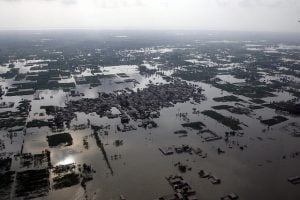The Doha outcome puts the world on track for three, four or even five degrees of warming, Mónica López Baltodano, of Centro Humboldt Nicaragua, an environmental NGO, has said. She attended Doha as a delegate from the South Pacific island nation of Nauru and represents the Alliance of Small Island States – the ones most likely to be wiped out first by rising sea levels.
It is not just low-lying island states that will be effected either. As the World Bank reported recently, a 4C world would be one of unprecented heat waves, severe drought and major floods in many regions.
The UK meteorological office produced a illustrative map a few years ago, detailing what a 4C world would look like. You can see the 4C map in full on their website. Although the average temperature rise over the globe is 4C (7 Farenheit) the rise will not be spread uniformly across the globe. The land will heat up more quickly than the sea, and high latitudes, particularly the Arctic, will have larger temperature increases. The average land temperature will actually be 5.5C above pre-industrial levels.
The impacts of the temperature rise will include a decline in major cereal crop yields, water availability issues in western China, where much of the river flow comes from glacial melt water and risks of flooding and storms to low-lying coastal regions (see chinadialogue article on flooding risk in Shanghai).


